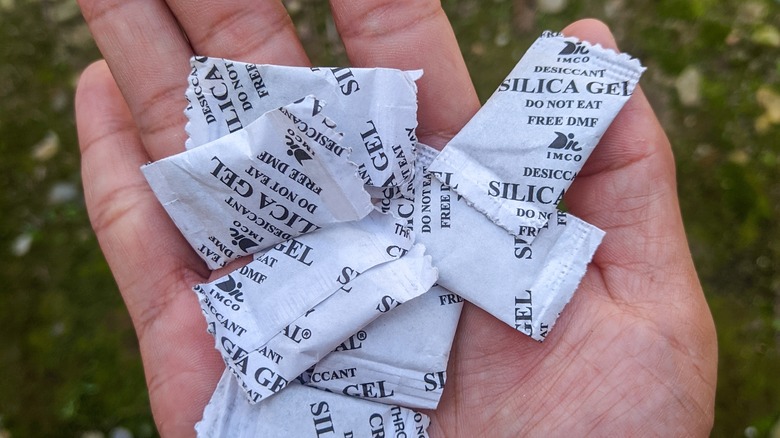Why You Should Be Reusing Silica Gel Packets In Your Tool Box
We may receive a commission on purchases made from links.
If you're an avid DIYer and live anywhere even slightly humid, you've probably had to deal with rusty tools. No matter how well you clean them or how neatly and carefully you store them, they eventually get coated in that dreaded red corrosion. Thankfully, the hack you need to stop tools from rusting lies in your next bag of grains or electronics purchase. Those little silica gel packs that keep the pair of shoes you just bought clean and dry in their packaging can help your tools, too. Just pop one (or a few) into your tool box and create a moisture-free environment for no money at all — okay, fine, for the cost of whatever the silica gel pack came in, we guess.
Rust develops when water on an iron or iron alloy object reacts with the oxygen in the air. In other words, it's hard to avoid since moisture and oxygen are literally everywhere. Most metal tools are made from steel and its alloys. Stainless steel has a reputation for rust resistance, but it's not impervious to moisture damage. Handmade tools crafted from iron are far more rust-prone. Wooden tool handles are also vulnerable to moisture, too, especially if whatever protective finish they once had has worn off with use. They harbor mold, and successive dry and damp periods could cause splitting and warping. Expose the componentry in, for example, your electric drill to too much water and the wires could deteriorate so much they fail to connect.
The science behind silica gel's moisture fighting power
Silica gel packets fall under a category of helpful materials called desiccants. As their name suggests, the porous outer bag is filled with silica, also known as silicon dioxide (SiO2). The granules of this naturally occurring mineral are covered in microscopic holes that effectively suck up all the teeny yet harmful droplets of water that humid air contains. Silica is shelf stable and doesn't react with anything, making it safe to use most anywhere. Silica gel beads are used for the preservation of ancient metal objects and other artifacts in museums around the world; it should easily do the same for your far newer and less precious (at least to the world of science) tools. They're also used to inhibit fungal growth (read: mold) in delicate optical lenses, which points to its effectiveness in keeping equally delicate componentry in your power tools and devices dry.
In order to save those silica gel packets for your tool box, you need to know where to find them. Look for these nifty moisture-ensnaring pouches in everything from the aforementioned shoeboxes to bags of rice or inside the leather handbag you just bought. You can, of course, also buy silica gel pouches online. The Rust Store sells a bag of 20 1-gram packets for under $6. Want something a bit heftier? A 10-count bag of 10-gram packets of premium Dry & Dry brand silica gel packets go for less than $8 at Walmart.
How many silica gel packets keep a tool box toasty?
It turns out that the effectiveness of this creative way to repurpose silica gel packets around the house doesn't correlate with packet size. In a University of Huddersfield study conducted in 2013, all of the sample weights of silica gel absorbed 100% of the moisture in the test area. If you feel like you really need some guidelines, Museums Galleries Scotland recommends archivists use the equivalent of 0.3 to 0.7 ounces of silica gel for every 10 square feet of enclosed space. In other words, one regular-sized packet should be enough for a tool box. The packet should be completely dry. If it's not, bake it in the oven for 24 hours at 245 degrees Fahrenheit or use the residual heat from a recent cooking session. Silica gel works best in sealed spaces, so keep your tool box firmly closed and locked shut when you're not using it.
You've probably noticed the big "DON'T EAT" warnings emblazoned across packets of silica gel. While many people automatically assume they indicate the gel beads inside the little bags are toxic to ingest, they're actually not. Instead, the warnings are there because the packages themselves, as well as the granules inside them, are a choking hazard, especially for kids and pets. Do, however, make sure the silica gel packets you use contain white or orange silica beads. If the granules inside are blue, they contain toxic cobalt chloride, making them potentially unsafe.

